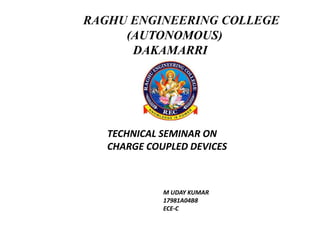
CHARGE COUPLED DEVICES
- 1. RAGHU ENGINEERING COLLEGE (AUTONOMOUS) DAKAMARRI M UDAY KUMAR 17981A04B8 ECE-C TECHNICAL SEMINAR ON CHARGE COUPLED DEVICES
- 2. OBJECTIVE • Study and observe working and application of charged coupled devices
- 3. INTRODUCTION TO CCD’s • CCDs are used to convert light into a digital value • The CCD captures light and converts it to digital data that is recorded by the camera. • It can be defined as a light-sensitive integrated circuit imprinted on a silicon surface to form light-sensitive elements called pixels, and each pixel is converted into an electrical charge.
- 4. TYPES OF CCD’S There are different CCDs such as • Electron multiplying CCDs, • Intensified CCD, • Frame-transfer CCD • Buried-channel CCD.
- 5. WORKING • They transfer incoming photons into an electrical charge in the CCD chip • The photons are received in a photoactive region of silicon • A lens is used to focus the light onto the silicon • A charge is accumulated in the capacitors proportional to the light intensity • Each photo site corresponds to an individual pixel in the final image and photo sites are often referred to simply as pixels.
- 6. • Each “photo sites” will refer to the CCD chip and “pixels” will refer to an image. • When a photon of light strikes the surface of certain metal materials the energy imparted by the photon can release an electron from the metal. • In a CCD, this electron is stored within the walls of a photo site
- 7. HOW TO GET DATA FROM CCD’S • Photo sites are read out, one row at a time, into a serial register along the bottom of the CCD array. • The serial register then transfers the charge from each photo site to an output node. • From there the charge is sent to the camera’s electronics unit where the electrons are digitized.
- 8. 8 CCDs can be used to collect an image in one of three ways, either one pixel at a time, one row at a time, or as an entire area at once.
- 9. How is an image made with a CCD chip? • There are three main phases: Clearing phase Exposure or integration phase Readout phase 9
- 10. How a CCD chip registers image? • The telescope projects an image on the CCD chip. High intensity areas will produce more charge in the pixels than low intensity areas. • The amount of charge in every pixel makes the image. • The computer can read this charge and convert it to an image 10 oThe value in every pixel gives the charge, which is related to the light intensity.
- 11. Clearing phase • Mostly you don’t have a shutter in your camera, this means that there is always light falling on the CCD chip. • When you want to make an image, all existing charge has to be removed from the pixels. • The lowest line will move the charge to a clearing line, where it will be removed. • When all lines are shifted away, there is no charge left anymore 11
- 12. Exposure or integration phase • The lens projects the image on the CCD chip, so charge will accumulate in the pixels. • The longer you wait, the more light will be registered by the chip. • This phase controls the exposure time, also called: integration time, • because the chip integrates the amount of light in a certain period. With lunar and planetary photography it usually takes a few tenths of a second, but it can take minutes or even hours
- 13. Readout phase • To get the image in your computer, it will have to read the amount of charge of every pixel. • There is a device, the charge detection node, in the CCD chip that is able to measure the charge of a pixel • When all pixels of the line are measured, all lines are shifted one line down. • Then again the lowest line can be measured. This will be repeated until all lines are measured. • The computer can read the measurements through the camera electronics 13
- 14. Applications • CCDs are used in digital cameras, optical scanners and video cameras as light-sensing devices. • CCD cameras used in astrophotography. • CCDs are typically sensitive to infrared light, which allows infrared photography, night-vision devices , video recording/photography. • CCD are use to take exposures of galaxies and nebulae 14
- 15. Advantages o Relative simple o More sensitive than photographic film o Cheaper to replace if failure o Modularity-easy upgrades o Detector costs simple o No chemical processing is needed 15
- 16. DISADVANTAGES • CCD sensors consume much much more power. • HD video-less pixel rates. • CCDS are expensive as they require special manufacturing. • CCD sensors may be wired/wireless-mastering the use requires some effort and learning period